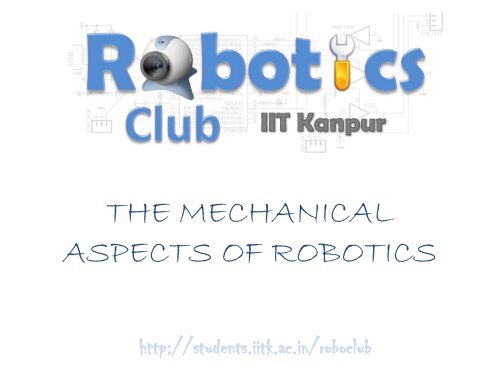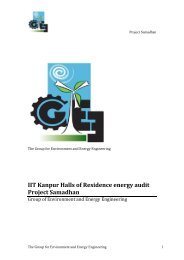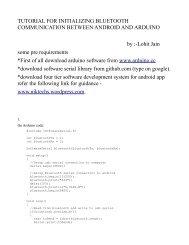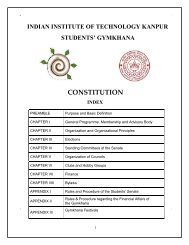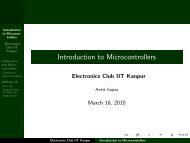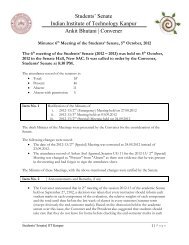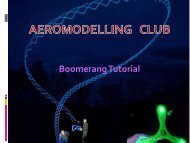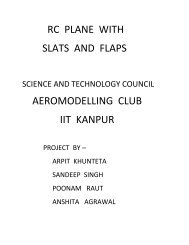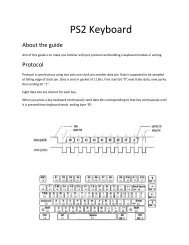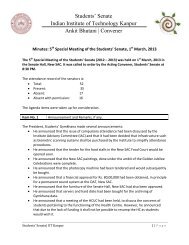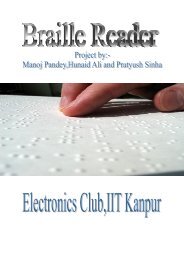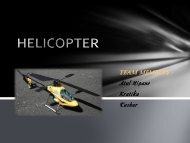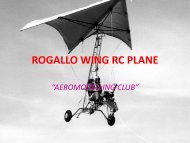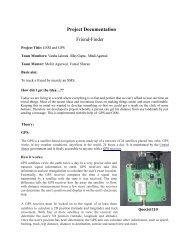THE MECHANICAL ASPECTS OF ROBOTICS
THE MECHANICAL ASPECTS OF ROBOTICS
THE MECHANICAL ASPECTS OF ROBOTICS
You also want an ePaper? Increase the reach of your titles
YUMPU automatically turns print PDFs into web optimized ePapers that Google loves.
<strong>THE</strong> <strong>MECHANICAL</strong><br />
<strong>ASPECTS</strong> <strong>OF</strong> <strong>ROBOTICS</strong><br />
http://students.iitk.ac.in/roboclub
Mechanical<br />
aspects<br />
Actuators<br />
The basic<br />
structure<br />
Circuitry<br />
Motors (DC<br />
Motors, Servo,<br />
Stepper, Encoder)<br />
Hydraulics<br />
Mechanisms<br />
(gears, etc.)<br />
Micro-controller<br />
(Arduino)<br />
The motor drivers<br />
(L293D, L298,<br />
MOSFET)
DC Motors<br />
• These are simple motors used for<br />
simple purpose.<br />
• Apply +12V (generally) and they start<br />
rotating. Apply -12V and they rotate<br />
in the opposite direction!<br />
• Speed can be reduced by reducing the<br />
voltage supplied, however that’s not<br />
an efficient way of doing things.<br />
• Torque and speed are inter-related. A<br />
10rpm motor has relatively high<br />
torque. Generally a 100rpm – 300rpm<br />
motor is used as the wheels of a robot
Servo Motors<br />
• They are used for specific purposes (for<br />
instance, in grippers, etc.)<br />
• They have a restricted rotation of 180 o or<br />
360 o . The least rotation angle possible is<br />
1 o .<br />
• They are driven through<br />
microcontrollers. Power comes separately<br />
from a battery (12V, generally).<br />
• Arduino has one line command for<br />
driving a servo . Using an Atmega PWM<br />
needs to be generated to drive a servo.<br />
• Speed can be reduced by sending the<br />
commands at a delay. This doesn’t reduce<br />
the efficiency of the motor.
Stepper Motors<br />
• Stepper motors, unlike ordinary DC<br />
motors, are brushless and can divide a<br />
full 360° into a large number of steps, for<br />
example 200.<br />
• Unlike servo motors, their rotation is<br />
not restricted.<br />
• Stepper motors have got a different<br />
mechanism for rotation. The four<br />
electromagnets are activated successively<br />
and this causes the disc to rotate. Each<br />
activation results in a small rotation,<br />
called a step, generally of 1.8 o .<br />
• Again, speed can be varied by applying a<br />
delay in the control signal send to the
Encoder Motors<br />
• High quality DC motors, with a feedback mechanism.<br />
• The encoders can be optical or magnetic.<br />
• They measure the rotation of the DC motor and give a feedback of<br />
the amount of rotation done, so that the rotation can be controlled.<br />
• Finds use in situations similar to where stepper motors are used.
Circuitry (Driving the motors)<br />
• The microcontrollers like Atmega16 and Arduino have a current<br />
rating of 5-10 mA.<br />
• The normal DC motor’s current ratings start from 150 mA and<br />
above.<br />
• So the motor cannot be directly attached to the Atmega, hence a<br />
motor-driver is used.<br />
• Generally, L298, L293 are used to drive simple DC motors. The<br />
servo motors already have a power cable and a different control<br />
cable which can directly be connected to the microcontrollers.<br />
L298, UART can drive the stepper motors.<br />
• More about the circuitry will be covered in the further lectures…
The mechanical model<br />
• Different mechanical models are made depending on the task<br />
needed to be achieved through the robot.<br />
• This is where the innovation lies!<br />
• While designing a mechanical model we need to think about the<br />
task, the time, the feasibility; we need to think in different<br />
dimensions.<br />
• We shall discuss some methods of motion transference through<br />
gears and other utilities. However, implementing them is difficulty<br />
because while implementing we can face various difficulties of<br />
giving support, ensuring less friction, proper synchronization, etc.<br />
Also, arranging particular type of gears is difficult.
Rotation to linear motion<br />
We many-a-times need some linear motion in our<br />
robots.<br />
In the forthcoming slides I have listed some of the<br />
mechanisms that I have used. You may come up with<br />
your own!
2. Rack and Pinion
4. Conveyer Belt<br />
This is a simple way to achieve linear motion. It doesn’t have<br />
much complicacies and could be easily implemented. I used it in<br />
my robot.
Other mechanisms<br />
• Scissor mechanism<br />
• Spring mechanism
Some other useful things<br />
Ball Bearings.<br />
• Support for minimizing<br />
friction.<br />
• Generally not needed,<br />
as friction is not much<br />
Omni wheels.<br />
• Special types of wheels<br />
is motion is desired in<br />
both x and y directions.<br />
Castor wheels.<br />
• Provides a one point<br />
support minimizing<br />
friction.
Thank You!<br />
Prashant Jalan, B-306/5, 8960402355<br />
Abhishek Attal, 273/2, 8009961678<br />
Saket Kanodia, A326/10, 8765696051<br />
https://www.facebook.com/groups/roboclub.iitk/<br />
http://students.iitk.ac.in/roboclub/


